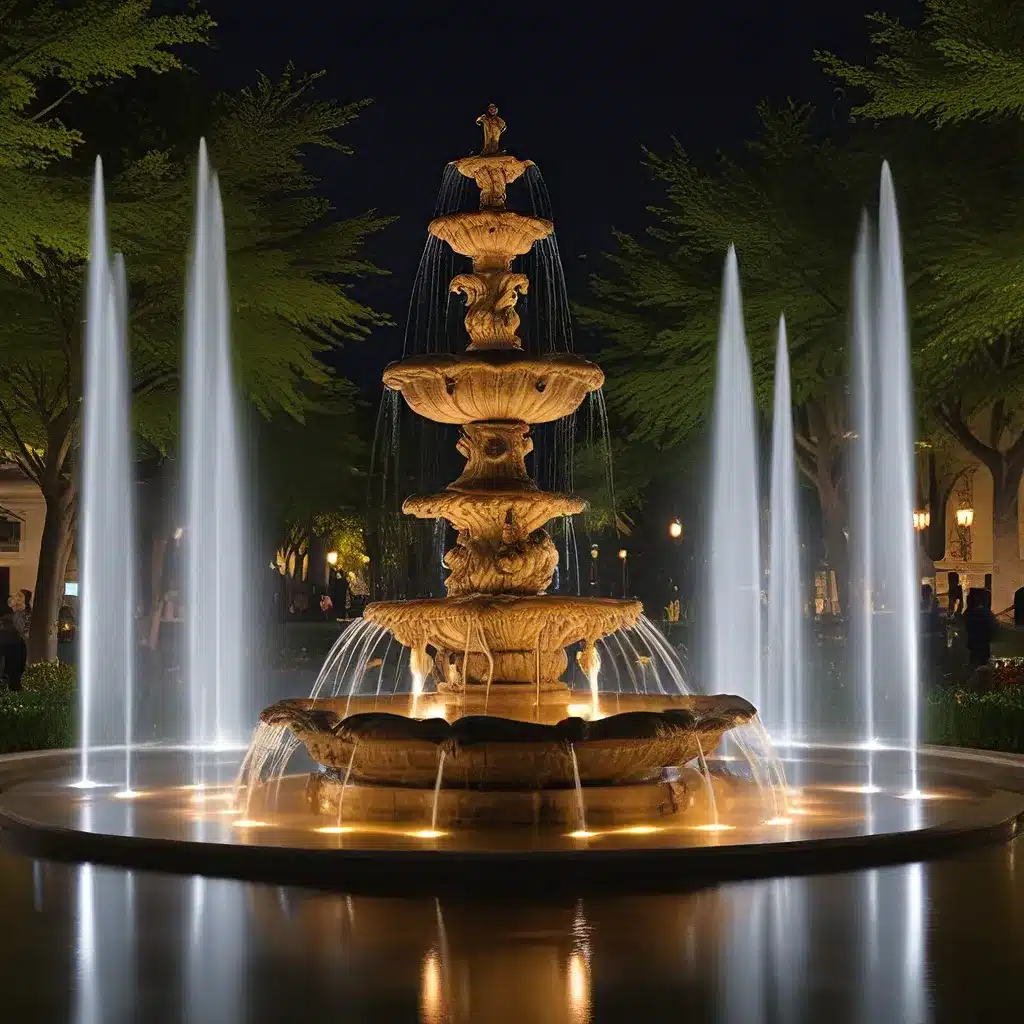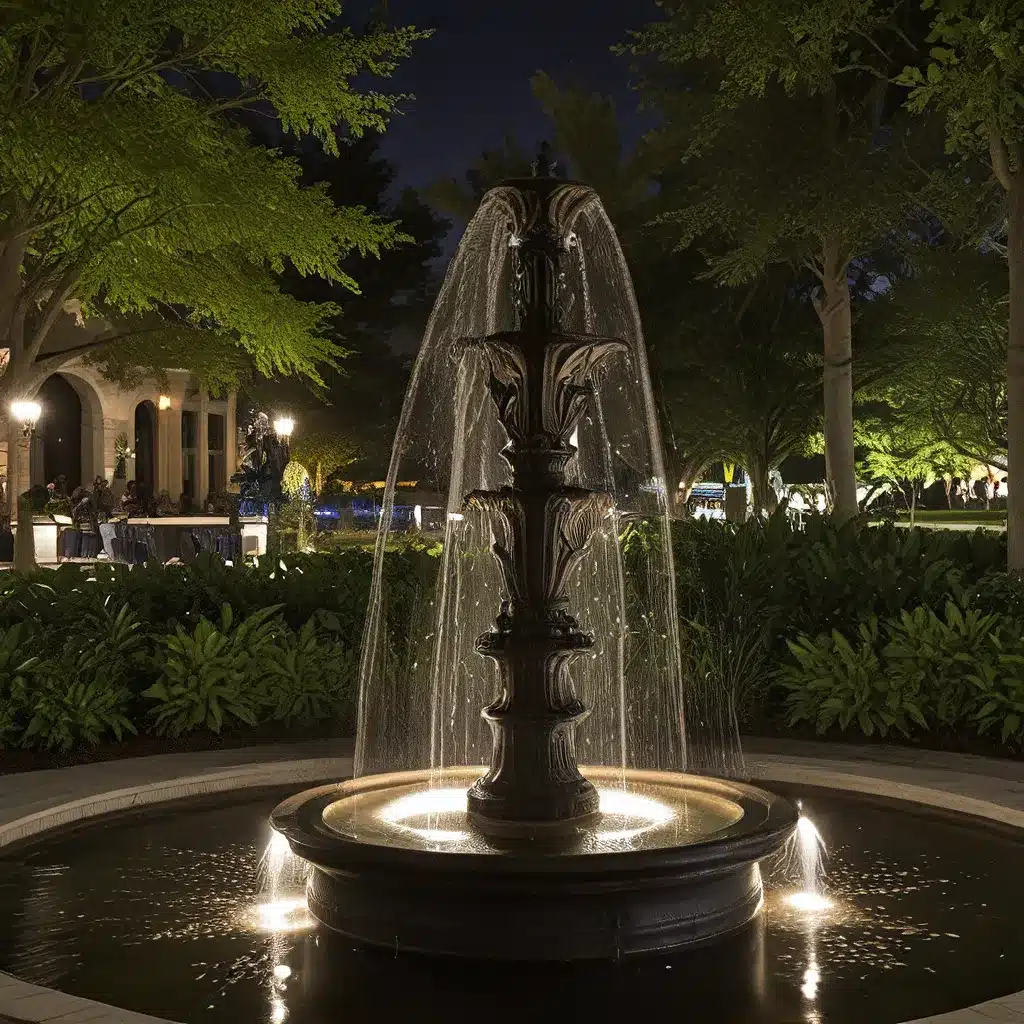
Fountain Design Essentials – Welcome to Fountain Lights
Fountain Design Essentials – Welcome to Fountain Lights

Ah, the world of fountain lighting – where the interplay of water, light, and engineering come together to create truly mesmerizing displays. As an avid fountain enthusiast, I’ve learned that the key to crafting a captivating fountain experience lies in the heart of the system – the pump. And let me tell you, the advancements in fountain pump technology have been nothing short of revolutionary.
Back in the day, fountain pumps were a bit like the old-school flip phones – functional, but not exactly what you’d call ‘smart.’ They were often loud, inefficient, and prone to clogging, leaving fountain owners constantly on the lookout for the dreaded sputtering sound that signaled impending doom.
But oh, how times have changed! The modern fountain pump is a true marvel of engineering, boasting features that would make even the most tech-savvy among us do a double-take. These pumps are designed for efficiency, sipping energy like a hummingbird sipping nectar, and they’re built to last, shrugging off debris and weathering the elements with ease.
Now, I know what you’re thinking – with all these fancy pumps out there, how do you even begin to choose the right one for your fountain? Fear not, my friends, for I’m here to guide you through the process.
First and foremost, you need to consider the size and flow rate of your fountain. After all, you don’t want to be trying to push a firehose through a garden hose, do you? No, sir – that’s a recipe for disaster. You’ll need to carefully measure the dimensions of your fountain and calculate the desired water flow rate, taking into account factors like the height of the water feature and the overall design.
Once you’ve got those numbers dialed in, it’s time to start exploring pump options. Now, I could go on and on about the various pump types and their specific features, but let’s focus on the two major categories: submersible and external.
Submersible pumps are the workhorse of the fountain world. They’re designed to be fully submerged in the water, quietly and efficiently circulating the liquid through your fountain’s plumbing. These pumps are ideal for smaller to medium-sized fountains, as they’re compact, easy to install, and require minimal maintenance.
One of the standout features of submersible pumps is their energy efficiency. Thanks to advancements in motor and impeller design, these pumps can deliver impressive flow rates while using a fraction of the power of their older counterparts. And let’s not forget about their resilience – these babies are built to withstand the harsh aquatic environment, shrugging off debris and mineral buildup with ease.
Now, if you’re looking to power a larger or more complex fountain, an external pump might be the way to go. These bad boys are installed outside the water, often in a dedicated equipment room or enclosure. And let me tell you, they pack a serious punch when it comes to flow rate and pressure.
External pumps are perfect for fountains with multiple tiers, intricate water features, or even those that need to push water up to great heights. They’re also easier to maintain, as you can access the components without having to dive into the fountain itself.
But with great power comes great responsibility (or something like that). External pumps tend to be a bit more energy-hungry than their submersible counterparts, so you’ll need to factor in the overall energy consumption and plan accordingly.
Alright, now that you’ve got the basics down, it’s time to start dialing in the specifics. When it comes to fountain pumps, there are a few key specifications you’ll need to pay attention to:
Flow Rate: This is the measure of how much water the pump can move per minute, usually expressed in gallons per minute (GPM) or liters per minute (LPM). Matching the flow rate to your fountain’s requirements is crucial for achieving the desired water effect.
Horsepower (HP): This refers to the pump’s power output, which directly impacts its ability to move water and overcome any resistance (like height or distance). Higher HP means more oomph, but you’ll need to balance it with energy efficiency.
Head Height: This is the maximum vertical distance the pump can push water. Taller fountains will require pumps with higher head heights to ensure the water reaches the desired height.
Electrical Requirements: Fountain pumps come in a variety of voltage and amperage configurations, so make sure your power supply can handle the pump’s needs.
When selecting a pump, don’t just go for the biggest and baddest – that could end up being overkill and a waste of energy. Instead, carefully consider your fountain’s specific requirements and choose a pump that’s perfectly sized to deliver the performance you desire.
Alright, so you’ve got your shiny new pump installed and your fountain is looking better than ever. But the work doesn’t stop there, my friends. To keep your pump running at its best, you’ll need to stay on top of regular maintenance.
First and foremost, inspect the pump and filter regularly for any signs of debris or buildup. Clogged intakes and impellers can seriously hamper the pump’s efficiency, so a little proactive cleaning can go a long way.
And don’t forget about those electrical connections! Loose or corroded wiring can lead to all sorts of issues, from reduced performance to complete pump failure. Give those connections a once-over every few months to ensure everything is ship-shape.
Lastly, keep an eye on the pump’s energy consumption. If you notice a sudden spike in your power bill or the pump seems to be working harder than usual, it could be a sign of an underlying problem. Addressing these issues early can save you a lot of headache (and money) down the line.
Now, as much as I love talking about pumps, I can’t forget the true star of the show – the fountain lighting. After all, what good is a beautifully flowing fountain if it’s not showcased in all its glory?
Fountain Lights has been at the forefront of the lighting revolution, offering a dazzling array of options to make your fountain the envy of the neighborhood. From energy-efficient LED fixtures to programmable color-changing systems, they’ve got the tools to transform your water feature into a mesmerizing work of art.
And the best part? These lighting systems are designed to work seamlessly with your fountain’s pump, ensuring that the water and light are perfectly in sync. No more fumbling with separate controls or worrying about compatibility issues – it’s all plug and play for a truly cohesive and captivating experience.
So, what are you waiting for? Unleash the full potential of your fountain by pairing it with the latest and greatest in lighting technology. Your neighbors will be green with envy, and you’ll be the talk of the town.
As you can see, the world of fountain pumps and lighting is constantly evolving, with innovative solutions that push the boundaries of what’s possible. By staying informed and embracing the latest advancements, you can create a fountain experience that captivates and delights all who behold it.
So, whether you’re planning a new fountain project or looking to breathe new life into an existing one, don’t be afraid to explore the cutting-edge of fountain technology. The possibilities are truly endless, and with the right pump and lighting system, you can transform your outdoor space into a mesmerizing oasis that will leave a lasting impression on all who witness it.
Share to :
Subscribe to our newsletter for the latest in fountain design, innovative lighting ideas, and exclusive tips straight to your inbox. Join the community shaping the future of water features.

Rapid delivery to your doorstep.

Excellence in every product.

Great value for your investment.

Assistance at any hour.
Fountain Lights — Illuminating creativity in every splash!
Copyright © 2023. All Right Reserved